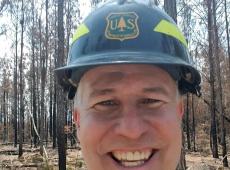The need for science to improve the application of prescribed fire has never been greater. Increasing complexity, be it from altered land use patterns, changing climate, or invasive species is challenging Rx fire managers ability to maintain, let alone increase fire treatments across the south. Realizing that there are mature but underexploited technologies such as LiDAR and new coupled fire-atmosphere models such as QUIC-Fire, we are building a network of expertise to develop a modular and unified approach to improving prescribed fire through better predictions of both fire behavior and fire effects. The strategy has led to new techniques being adopted in the southern region for fuels and vegetation inventory and monitoring and has initiated other spinoffs such as the detection of new archaeological features across the landscape. I will present results of the approach from a demonstration conducted at the Hitchiti Experimental Forest and Piedmont National Wildlife Refuge.
The Athens Prescribed Fire Technology Hub, an integrated approach to informing prescribed fire management
Presenter Biographies
Joe O’Brien is a Research Ecologist and the Project Leader at the Center for Forest Disturbance Science of the USDA Forest Service Southern Research Station. Since joining the Forest Service in 2002, Joe’s research has centered on fire science, specifically the spatial interactions among wildland fuels, fire behavior and fire effects. His graduate training and prior work experience have given him expertise in plant ecology and ecophysiology, conservation science and forest management. He has global fire experience with active research on fire ecology in Latin America and the Caribbean. He has worked as an ecologist in the southeastern US and neotropics for 33 years. He received a bachelor’s degree in Biology from SUNY Geneseo in 1986 and his master’s and Ph.D. in Biological Sciences from Florida International University in 1997 and 2001 respectively.
